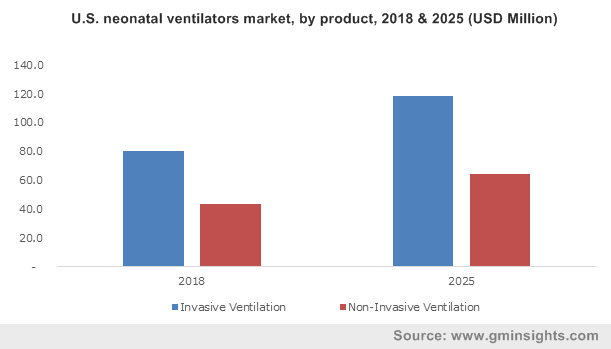Unveiling neonatal ventilators market in terms of the regulatory frame of reference: Africa to emerge as a profitable growth avenue over 2017-2024
Publisher : Fractovia | Published Date : 2018-01-30Request Sample
The growing demand for respiratory devices for infants, in tandem with rising infant mortality rate, will indeed impel neonatal ventilators market size in the ensuing years. As per the UNICEF, globally, per 1000 infants, merely 19 children manage to survive. In 2016, 2.6 million babies apparently died in the neonatal period. This perpetually huge number could be avoided with effective neonatal resuscitation and positive pressure ventilation to aid a newborn’s normal respiratory function, which leads to a rise in the demand for such ventilators, subsequently boosting boost neonatal ventilators industry share over the years ahead. In addition, the increasing prevalence of a wide range of diseases such as respiratory muscle dysfunction, increased airway obstruction, refractory hypoxemia, and decreased ventilator drive will also have a considerable influence on neonatal ventilators industry trends. It is also indeed pivotal to mention that the intervention of regulatory bodies such as FDA and WHO in the development of advanced mechanical ventilators in order to minimize neonatal mortality, will generate lucrative business opportunities for the giants in neonatal ventilators market.
U.S. Neonatal Ventilators Market size, By Product, 2013-2024 (USD Million)

At present, various hospitals are known to lack highly advanced neonatal units, leading to the death of numerous infants. In this regard, several biggies in neonatal ventilators market have been establishing joint ventures with hospital groups to deploy advanced facilities in the neonatal unit. For instance, in 2013, GE Healthcare signed an agreement with a renowned group purchasing organization, HealthTrust to supply infant care facilities comprising warmers, phototherapy, and incubators. The company already provides Neonatal Intensive Care Unit (NICU) settings at most hospitals, which would further be enhanced via this partnership. Additionally, GE Healthcare is investing heavily in research and development activities to reduce the machine cost in order to make it affordable for the ordinary consumer. Correspondingly, most of the giants in neonatal ventilators market are primarily focusing on expanding their healthcare solutions to a large number of hospitals to provide advanced infant care and patient safety. This would consequentially impact neonatal ventilators market size, pegged at USD 250 million in 2016.
As per research, most of the African countries lack medical facilities that leads to a high infant death toll on an annual basis. In accordance, the World Health Organization plans to introduce numerous schemes that would help save the lives of newborns, through the implementation of maternal and child health programs across African countries. As per WHO reports, Africa contributes 11% of the world’s population but over 25% of the world’s infant deaths. Records claim that at least 10 African countries witness the highest risk of newborn mortality annually, including Liberia, where 6.6% of the newborns lose their life in the first month – the highest infant mortality rate in all the countries. Undeniably, armed with the intent to minimize the neonatal and maternal mortality rate, several governmental funding agencies and NGOs have been providing sufficient funds and advanced neonatal equipment to hospitals across Africa. For instance, in 2014, the Centre for Pregnancy and Childbirth Education, a non-governmental organization has handed over neonatal ventilators and patient monitors in collaboration with the Embassy of Japan to the pediatric unit of the 37 Military Hospital. The extensive involvement of NGO’s and governmental organizations in the development of neonatal healthcare infrastructure will thus effectively boost Africa neonatal ventilators market outlook over the years ahead. In fact, considering that the region requires several developments with regards to infant health, players in neonatal ventilators industry have been striving to expand their reach across African countries.
Speaking about the on-going advancements and the increasing availability of ventilators, the Irish healthcare product manufacturing company, Covidien Ltd. has launched three variations of the Puritan Bennett 840 Neonatalventilator in U.S. neonatal ventilators market. These types of neonatal ventilators are rather beneficial to manage, monitor, and deliver an excellent treatment regimen for critical neonatal patients. In addition, another manufacturer of anesthesia systems, intensive care and cardiovascular devices, Maquet has revealed the innovative design of general purpose and infant ICU ventilators, in which it has installed Neurally Adjusted Ventilatory Assist (NAVA) for improving the functionality of products. In essence, the considerable system upgradation and the development of new ventilation technologies will stimulate neonatal ventilators market size.
Taking into account the future challenges in healthcare sector, renowned players in neonatal ventilators market are focusing on research and clinical studies to examine the technical and economic issues related to ventilator technology. In fact, the emergence of new generation pneumatic components, next-generation sensors, and single chip solutions have had a positive impact on the design of ventilators. Moreover, regulatory bodies have already framed a technical baseline for giants in neonatal ventilators market in order to meet the growing requirement of affordable, appropriate, and good quality neonatal resuscitation devices for preventing newborn deaths. This would indeed have a transformational impact on the revenue graph of the overall neonatal ventilators market, the valuation of which is expected to surpass USD 430 million by 2024.